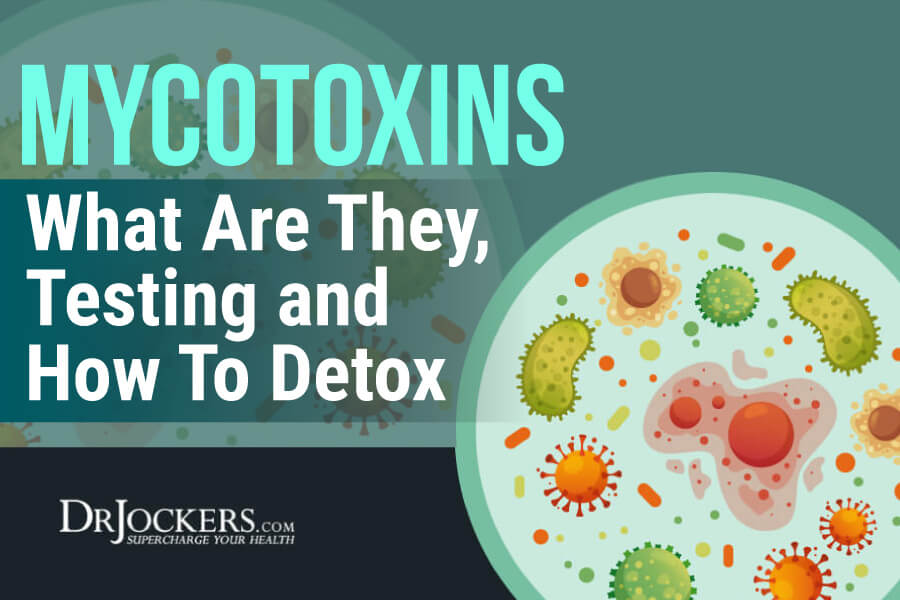 Mycotoxins: What Are They, Testing and How to Detox
Mycotoxins: What Are They, Testing and How to Detox
Mycotoxins are some of the most common toxins in our environment that may lead to serious health problems, including mycotoxin allergy, immune system issues, inflammation, and cancer. Mycotoxins may grow on your food and in your home under warm and damp conditions. Because they may lead to uncomfortable acute and chronic symptoms, a compromised immune system, and serious health problems, it is absolutely crucial that you detoxify your body from mycotoxins and control mycotoxins exposure in your life.
In this article, you will learn what mycotoxins are, how they affect your immune system, what are the symptoms of a mycotoxin allergy, and a list of foods that are the highest in mycotoxins. You will learn how to test for mycotoxins in your body with a simple test. I will share with you my best strategies to support mycotoxin detoxification.

What Are Mycotoxins
Mycotoxins are some of the most prevalent toxins in our environment that may lead to serious health problems. They are toxic compounds that are naturally found in specific types of fungi-like mold.
Fungi are able to grow almost anywhere under wet and warm conditions. This means that they can colonize on wallpaper, ceiling tiles, fiberglass insulation, and elsewhere in your home. Mycotoxins, or mold metabolites often infest buildings, vehicles, and certain foods.
They may grow on foodstuffs, such as cereals, bread, nuts, dried fruits, and spices. Mold growth and mycotoxicity may occur in food before or after harvesting or during storage. Leaving certain food in a warm, damp, or humid place may increase the risk of mold.
It is important to know that mycotoxins are chemically stable and are able to survive food processing. This means that you may not be safe from mycotoxins when buying or eating processed or packaged foods (1, 2).
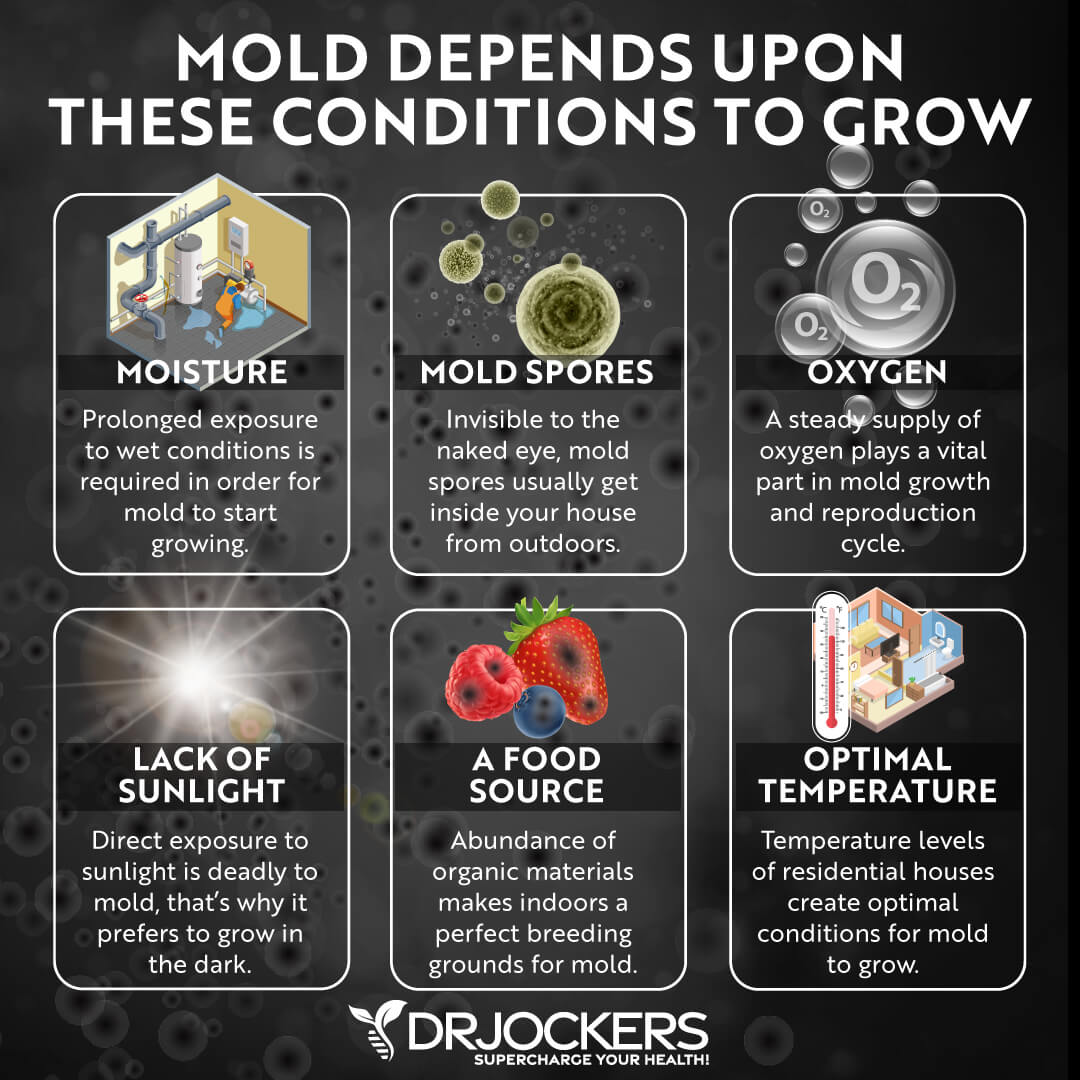
How Mycotoxins Impact Our Immune System
According to the World Health Organization, mycotoxins may cause acute symptoms of severe illness after the consumption of contaminated food products. They also warn that mycotoxins, especially in foods have been linked to serious, long-term health issues, including immune deficiency and cancer (1, 3, 4).
Ochratoxin A is produced by Penicillium and Aspergillus. It’s a common mycotoxin that may be found in contaminated foods, including dry vine fruits, wine, grape juice, coffee, cereal, licorice, and spices. It may lead to negative effects on your immune system, kidneys, and fetal development (1).
Pautin is another mycotoxin that is produced by Penicillium and Aspergillus, and Byssochlamys. It may be found in grains, rotting apples and apple products, moldy fruit, and other foodstuffs. It may have toxic and harmful effects on your immune system, liver, kidneys, and spleen. It may lead to nausea, vomiting, and gastrointestinal issues (1).
Fusarium is a fungus found in soil and produce and may lead to the formation of mold toxins. It may lead to suppression of the immune system, intestinal issues, and esophageal cancer (1).
Mycotoxins are particularly dangerous for people with a weakened immune system from an illness or drug treatment. Since their immune systems are already compromised, they are more likely to develop infections and symptoms in their skin, eyes, lungs, and other organs (1).
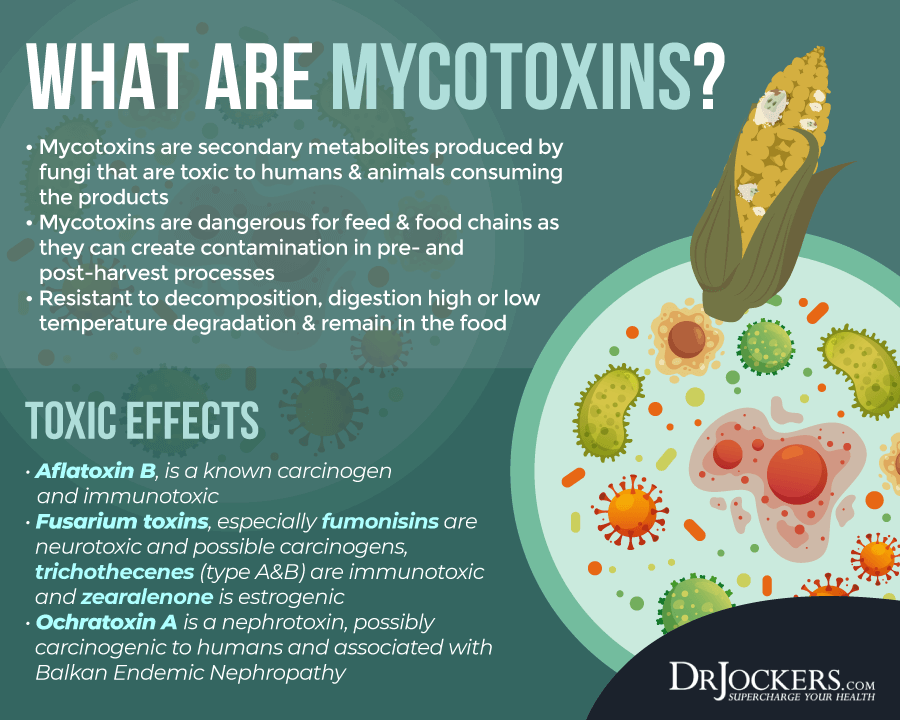
Symptoms of Mycotoxin Allergy
Exposure to mold may lead to mycotoxin allergy, sensitivity, or a variety of unwanted symptoms. People who are sensitive or allergic to mycotoxins may experience allergic reactions when inhaling mold or mold spores (5, 6).
Symptoms of mycotoxin allergy may include:
- Runny nose
- Sneezing
- Nasal congestion
- Watery eyes
- Itching
- Skin rashes
Mycotoxins may also lead to asthma attacks and similar symptoms causing:
- Wheezing
- Chest tightness
- Shortness of breath
Some people may develop respiratory infections or pneumonia after exposure of mold. While this is uncommon, it is important to keep in mind.
Mycotoxins may also lead to:
- Fatigue
- Sleeplessness
- Dry skin
- Hair loss
- Blurred vision
- Leaky gut syndrome
- Chronic pain
- Unexplained weight gain or weight loss
- Hormonal issues
- Numbness
- Insulin resistance
- Gut problems, such as nausea, diarrhea, and abdominal cramps
- Irritable bowel syndrome (IBS)
- Chemical sensitivity
- Blurred vision
- Fibromyalgia
- Behavioral changes
- Emotional changes

Foods Highest in Mycotoxins
One of the most common, yet sometimes unexpected ways to encounter mycotoxins is through food. Here is a list of foods that are the highest in mycotoxins (7, 8):
- Alcoholic beverages
- Wheat
- Barley
- Rye
- Sugar cane
- Sugar beets
- Corn
- Sourgum
- Peanut
- Cottonseed
- Hard cheeses
- Soybean Products
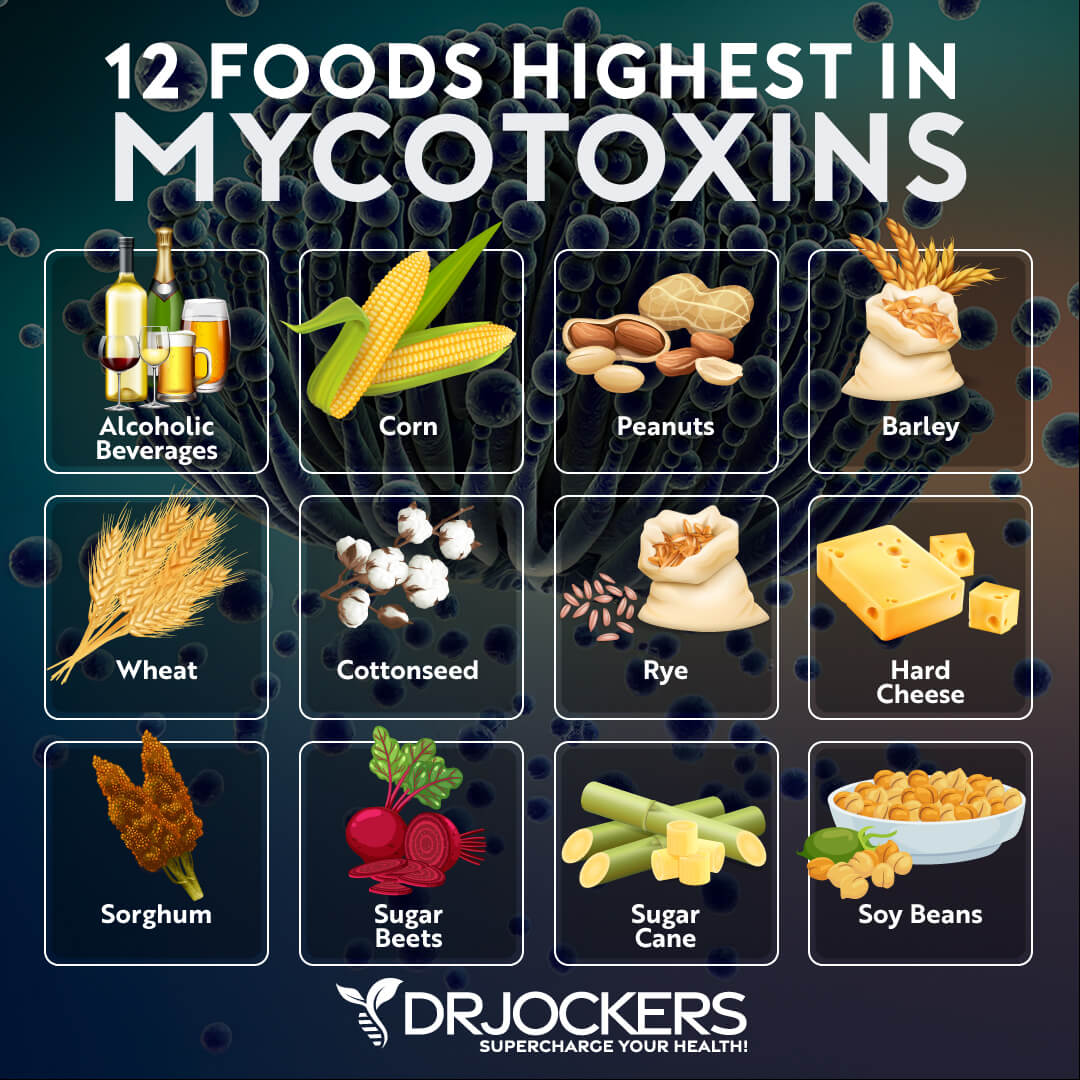
Testing For Mycotoxin Exposure
If you notice any symptoms of mycotoxins exposure or you suspect that you’ve been exposed to mycotoxins, it is a good idea to get tested in order to find the right treatment and solve your symptoms once and for all. I highly recommend this Mycotoxin test I use for my patients regularly.
This Mycotoxin test looks at every GPL-Mycotox markers, including Aflatoxin M1 (AFM1), Ochratoxin A (OTA), Sterigmatocystin (STG), Roridin E, Verrucarin A, Enniatin B1, Zearalenone (ZEA). It also tests for molds, such as Aspergillus, Penicillium, Stachybotrys, and Fusarium. You may learn more about these markers in this post.
This test is extremely simple. All you need is 10 mL of your first morning urine before any food or drink. Unless you are not running this test in combination with other urine tests, I recommend that you fast for 12 hours before testing to increase the excretion of mycotoxins from the adipose tissue.
Strategies to Detox Mold and Mycotoxins
Now that you understand the devastating effects mycotoxins may have on your health, you must be curious how to detox from mold and mycotoxins and prevent mycotoxin-related symptoms and illness. Read this list of some strategies I recommend to detox from mold and mycotoxins.
Low-Mycotoxin Diet
The first and one of the most important steps of mold and mycotoxin detox is following a low-mycotoxin diet. A low-mycotoxin diet may prevent mycotoxins from growing inside your body while simultaneously help to detox your system and restore nutrient deficiencies.
Some individuals will need to reduce their mycotoxin load in their diet by around 25-30% to see noticeable results. Meanwhile, others may need to reduce the mycotoxin load by 75-80% to see noticeable health results. The better your detoxification systems and home environment are, the better your body will deal with any mycotoxins you do ingest.
Foods to Avoid on a Low-Mycotoxin Diet
- Sugars and sugar foods:
-
- Sources of sugar, including table sugar, glucose, fructose, lactose, honey, maple syrup, molasses, sorbitol, mannitol, candy, and baked goods
- High-glycemic index fruits, such as mangoes, bananas, grapes, oranges, and melons
- Fruits that have a higher risk of mycotoxicity, such as apples and grapes
-
- Processed and packaged foods:
-
- Packaged and processed foods, including canned baked beans, canned soups, canned food in general, ready-made sauces, ready-made meals, breakfast cereals, and frozen foods
- Bottled drinks, including soft drinks, fruit juices, sodas
- Condiments, including pickles, relish, mustard, soy sauce, mayonnaise, and vinegar
-
- Mold and yeast containing foods, including:
- Cheese and sour milk products, such as sour cream, buttermilk, and hard cheeses
- Nuts, such as cashews, walnuts, and pecans
- Peanuts, beans and peas
- Dried fruits, such as dates, raisins, prunes, figs, and apricots
- Grains, such as wheat, rye, barley, oats, and rice
- Packaged and smoked meats, such as smoked fish, ham, hot dogs, sausages, bacon, corned beef, and deli meat
- Edible fungi, such as mushrooms and truffles
- Alcoholic beverages, such as beer, wine, cider, rum, gin, brandy, and whiskey
- Most types of coffee and chocolate
- Seeds such as quinoa, flax, hemp, pumpkin, chia
- Grain fed meats, because the animals are typically ingesting grains that are full of mycotoxins
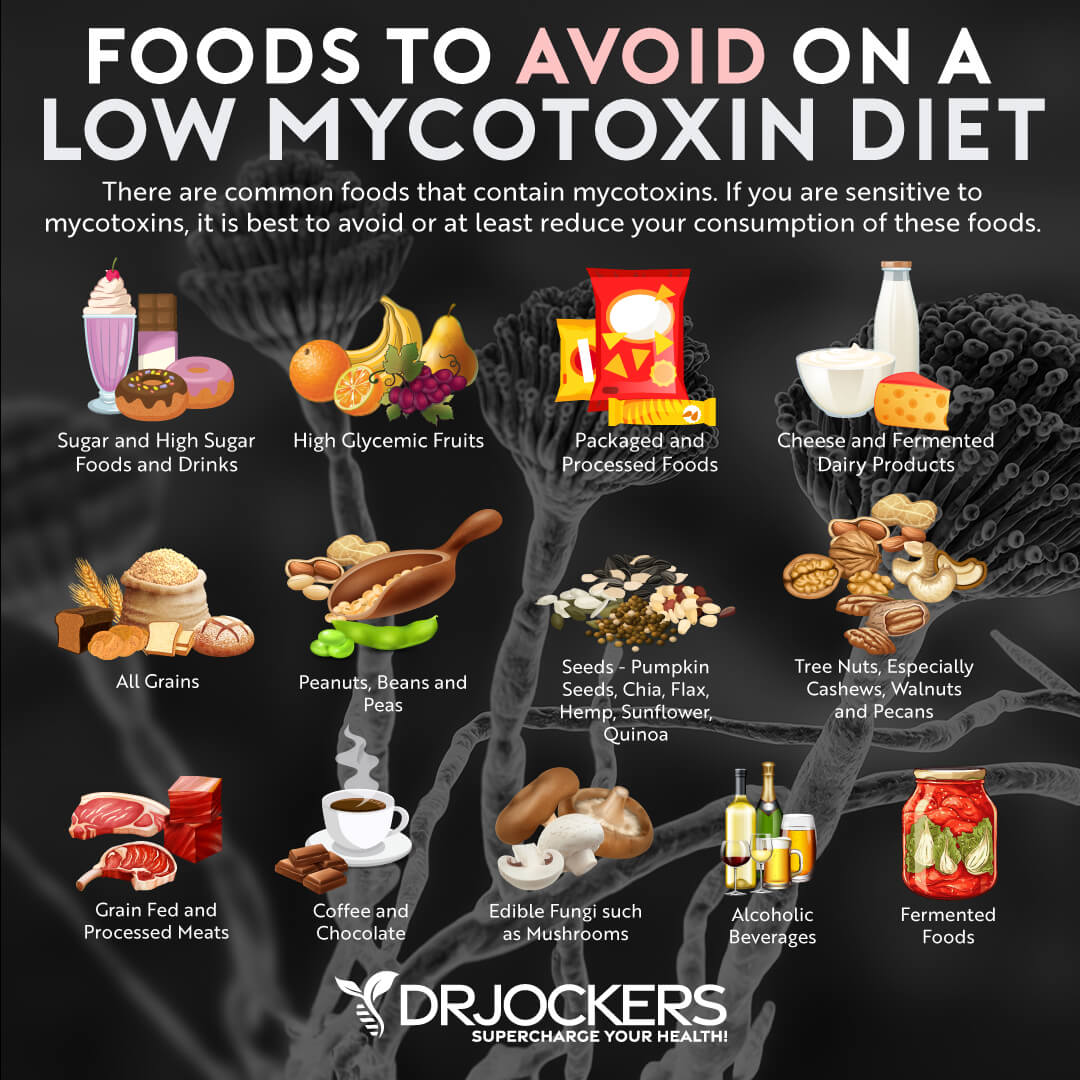
What to Eat on a Low-Mycotoxin Diet
Here is a list of the best foods to consume on a low-mycotoxin diet. It is important to remember that any food can have fungal toxins on it so it is important to visibly inspect the food and remove any parts that have spoiled or developed mold. Typically, if the food has developed mold, it is best to avoid it to be safe.
- High starch root vegetables such as sweet potatoes, carrots, beets, squash and pumpkin
- Low-sugar fruits, such as berries, pears, and peaches. Be sure to avoid any that have mold growing on them.
- Pasture-raised, organic poultry, including chicken, turkey, quail, and pheasant.
- Wild-caught fish, including salmon, sardines, anchovy, tuna catfish, and herring.
- Grass-fed, organic meat, such as ground beef, beef cuts, lamb, goat, and veal
- Leafy greens, including spinach, romaine, kale, collard greens, and cabbage.
- Vegetables, such as broccoli, cauliflower, celery, zucchini, cucumbers, onion, garlic, carrots, asparagus, and Brussel sprouts
- Herbs and spices, such as turmeric, ginger, mint, thyme, cayenne pepper, black pepper, cinnamon, cilantro, parsley, basil, oregano, rosemary, horseradish, tarragon, and Himalayan salt
- Healthy fats, such as avocados, coconut oil, coconut milk, organic butter and ghee, and extra virgin olive oil
- Beverages: filtered water, mineral water, herbal tea, fresh green juices, and fresh green smoothies
Many of the nutrition principles in a low-mycotoxin diet fit in line with the AutoImmune Paleo diet (AIP) and it is possible that one of the reasons people with chronic inflammation and autoimmune conditions seem to do very well on the AIP is due to the reduction in mycotoxins.
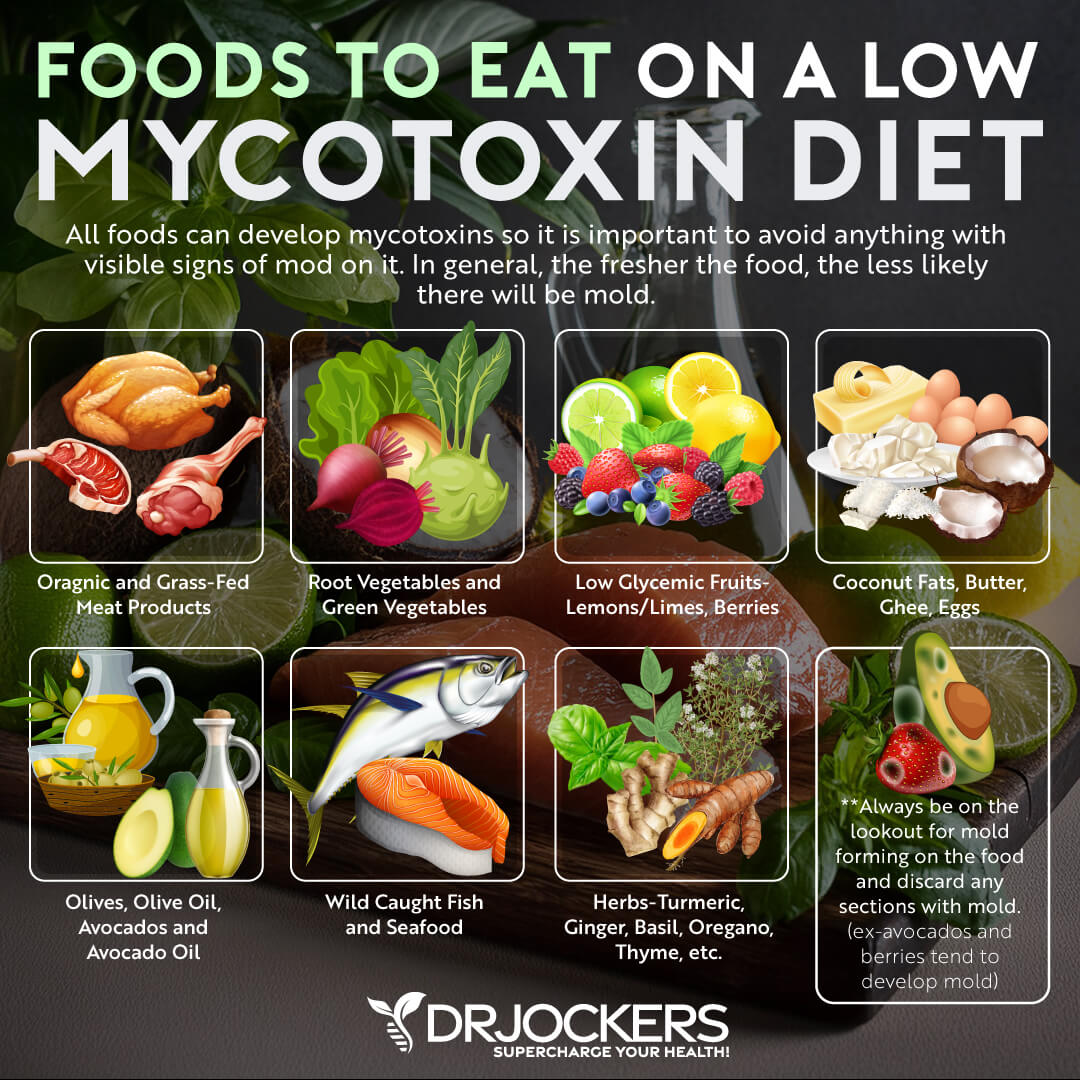
Good Hydration Strategies
Good hydration is essential for detoxification and your overall health. Water is absolutely essential to hydrate and rehydrate your body and move toxins out of your body effectively.
Make sure to drink at least 8 to 10 glasses of purified water a day. Drink more if you exercise a lot, it’s hot outside, you are sick, or you feel thirsty. To enhance the detoxification process and encourage an alkaline environment for healing, you may add some lemon or lime to your water as well. On top of your water intake, you may add some herbal tea, green juices, green smoothies, and hydrating fruits and veggies for extra hydration.
I recommend systems like Aquatrue or the Berkey system for low-cost filtration. The best water is the UltraLux Triple Action Hydrogen Water Machine which is what I use at home as it is powered by molecular hydrogen which reduces oxidative stress in the body and improves immune function.

Control Mold Growth in the Home
The next step of mycotoxin detoxification is controlling mold growth in your home. Mold detection starts with the smell. Mold generally has a damp and musty smell which is caused by microbial volatile organic compounds (mVOCs) produced by substances made by mold.
However, the smell is not always enough. You have to look for color and appearance to detect mold. These factors may also help to identify the kind of mold you are dealing with. Check for any water damage, leaks, broken water pipes, and other moisture problems to find any mold in your house. Color stains, discoloration, cracking, peeling, or bubbling of wallpaper or paint may be a sign of mold issues (9).
To control mold growth in your home, make sure to identify these potential problem areas and fix them. Dry wet areas immediately. Prevent moisture with a good ventilation system. Control your humidity. Clean your gutters. Keep mold off your houseplants. Use mold-resistant products (10). You may learn about the dangers of mold in your home in this article.
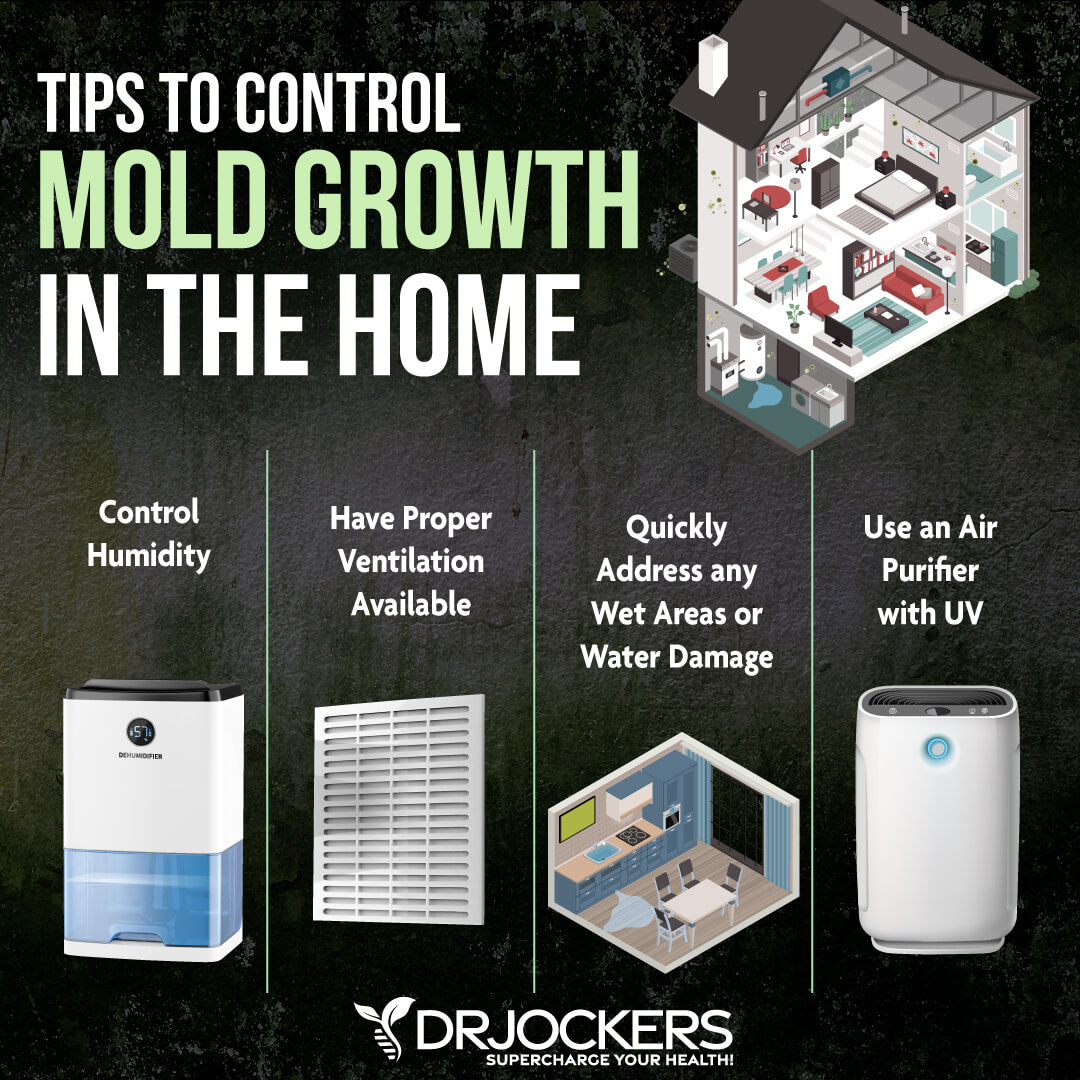 Air Filtration
Air Filtration
Treating your air at home is one of the most important things you can do to fight mycotoxins, detox your body, and eliminate your symptoms. Remember, mycotoxins can grow anywhere in your home in warm and moist areas, therefore they may release spores and toxins in the air and potentially harm your body. Therefore, an air purifier is an important strategy to combat this problem and filter microscopic toxins from your air.
I recommend the Air Doctor to ensure that everything is captured and destroyed keeping your home safe. What the Air Doctor does differently is that it has multiple filtration levels within an air-tight system. It uses a dual-action Carbon/Gas Trap/VOC filter for odor and VOC control. The Clean Air Delivery Rate (CADR) of this system is 326, which is much higher than its competitors.
While most hospital grade HEPA filters capture 99.97 percent of pollutants at 0.3 microns, Air Doctor goes 10 times further. It removes all particulate matter at .003 microns. It can remove all kinds of particles, including toxic ozone, organic chemicals, and gases. It has a formaldehyde filter, auto-sensor, digital display, and sealed system.
Support Liver and Glutathione Levels
An important step to detoxify from mold and mycotoxins is supporting your liver and glutathione levels. The best way to do this is with high-quality supplements.
I recommend Thyroliver Protect to support your liver and thyroid function. It may help liver detoxification, reducing inflammation, protecting your thyroid, balancing your blood sugar, blending adrenal function, improving energy, improving T4-T3 conversion, and strengthening your gut lining. Take two capsules a day for optimal benefits.
I also recommend Super Glutathione to support your glutathione levels. This supplement is a super antioxidant that may help to reduce inflammation, strengthen your immune system, slow the aging process, fill your with more energy, detoxify your body, reduce your risk of disease, and improve your athletic performance. Take it regularly for maximum support.
Take Mycotoxin Binders
To detoxify your body, I also recommend mycotoxin binders, such as GI Detox and BioToxin Binder.
Activated charcoal can be fantastic for mold and mycotoxin detoxification and cleansing. It traps toxins in your body and helps them to flush out preventing your body from reabsorbing them. My favorite product I recommend to my patients is GI Detox. It helps detoxification and healthy digestion. It is especially helpful if you have a higher mycotoxin meal. Take two or more capsules with food. You should also take it away from meals to pull out more toxins from the body.
BioToxin Binder binds in the gut and circulation. It supports your body’s detoxification process, binds mold, ammonia, and aldehydes, and helps to remove toxins from your body. It is especially beneficial if you have a mold or mycotoxin related illness or symptoms. Take one capsule three times a day for optimal benefits.
Final Thoughts
Mycotoxins are some of the most common and dangerous toxins in our environment. They can be found in some of your food and hidden in your home. Mycotoxins may lead to uncomfortable acute and chronic symptoms, a compromised immune system, and serious health problems.
Hence it is very important that you detoxify your body from mycotoxins and control mycotoxins exposure in your life. Follow my best strategies as outlined in this article to support mycotoxin and mold detoxification and to regain and enjoy the best health you desire.
Inflammation Crushing Ebundle
The Inflammation Crushing Ebundle is designed to help you improve your brain, liver, immune system and discover the healing strategies, foods and recipes to burn fat, reduce inflammation and Thrive in Life!
As a doctor of natural medicine, I have spent the past 20 years studying the best healing strategies and worked with hundreds of coaching clients, helping them overcome chronic health conditions and optimize their overall health.
In our Inflammation Crushing Ebundle, I have put together my very best strategies to reduce inflammation and optimize your healing potential. Take a look at what you will get inside these valuable guides below!

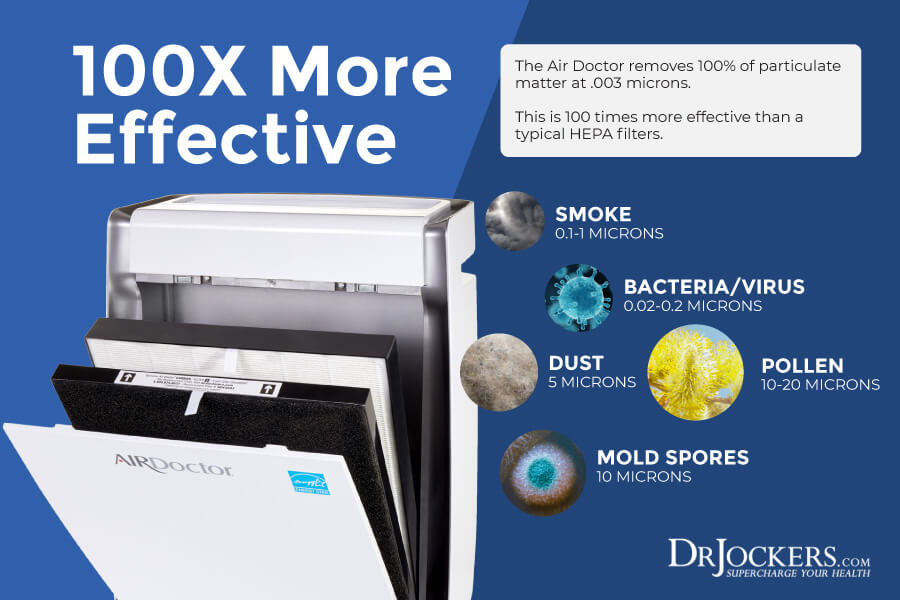


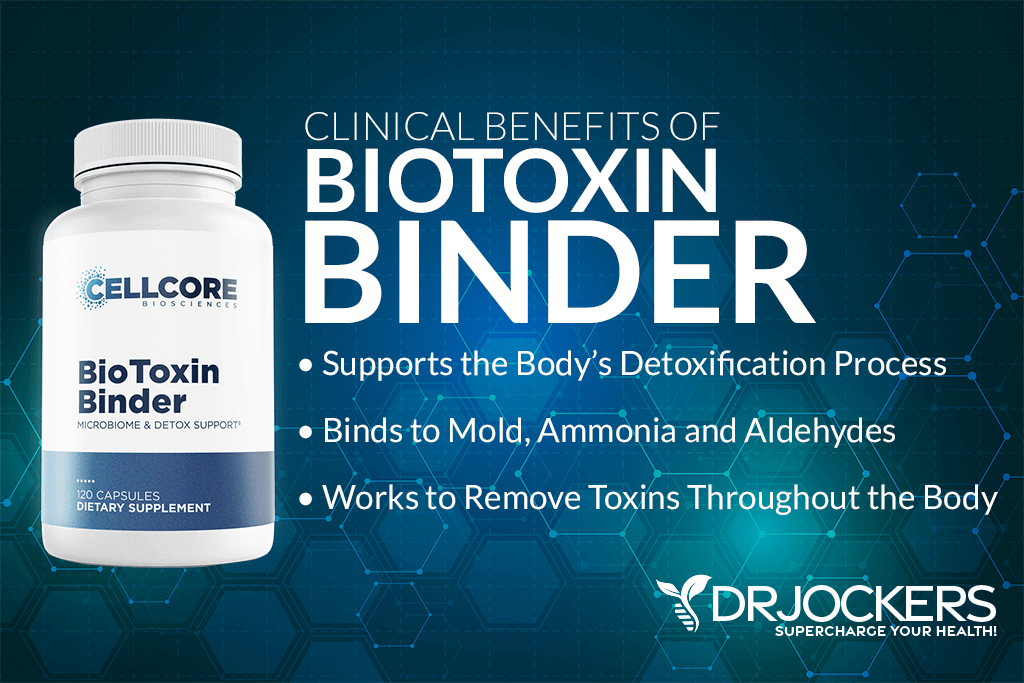




Mycotoxins are to small to be removed by any normal HEPA Filter. This should be explained in your article.
That is very true and that is why I recommend the EnviroKlenz which has Earth mineral technology that can trap and destroy mycotoxins.
Thanks you, Dr Jockers, for getting important info like this out to us.
Thanks Judy! Blessings to you!
Living in Mexico I can’t purchase your products, and I have less options for quality, fresh food (no Whole Foods or other quality food delivery services here); and most produce is past it’s prime even if it is organic by the time it reaches the shelves here. So I’m looking for ways that are realistic here AND to stay healthy. I don’t want to eliminate all the nuts/seeds, dates, quinoa, legumes, flax/chia/hemp seeds we eat (if possible) since they bring us joy and are a big part of our diet (some of the rare ‘super/health foods’ available to us here). Without them, will be eating a very narrow, bland and uninteresting diet in our interest of eating healthy. So what is the answer here? I find very little info online but I’m wandering is ‘soaking/rinsing’ these foods with Grapefruit Seed Extract first could be helpful? Thoughts?
Yes that may be helpful Jessica. Blessings to you!
What is the best product you have for tinnitus/meniere’s from mold/water damage exposure?
Have been binding and taking a ton of supplements after moving out of culprit home for over a year, now living in a brand new home but the ears/vestibular system is what is left to fix, and I’m having a hard time finding the right supplements.
Thank you!
Hey Connie,
Really sorry to hear this! For nerve regeneration, I like Alpha lipoic acid. It is important to stay on the binders while using this. I would try doing 2 caps in the AM and 2 caps at night of this product https://store.drjockers.com/products/ala-power-cr
Hi is there any supplementation to avoid or maybe include prior to this type of testing? Thank you!
Just to be on the safe side, I would avoid any fermented foods and supplements for 3 days prior and any medicinal mushrooms such as reishi, lion’s mane, cordyceps, etc for 3 days prior.
thank you for all this great info!! I have a few questions about this air machine for mycotoxns.
1. I noticed the CFM rating isn’t very high on this machine is that becasue the mycotoxins need more time to be exposed to the UV light?
2. what do you think about the hepa filters that can pick up down to .003microns? I know of 2 brands. could they be effective?
3. I have about 700 sq ft 9’t ceilings .so i think that means I would need about 3 of those machines (just a rough guess) in my water damaged apartment ? I think the goal is 4 air changes an hour? that gets expensive – is there a “next best” air filter solution that isn’t as expensive?? thank you Dr. Jockers!!
Yes this is the best for myctoxins but the Air Doctor is a lower cost unit that can help as well: https://drjockers.com/air-doctor/
My concern is using mycorrhizae fertilizer for indoor growing of plants. Will it cause breathing problems for people or pets? I have a fan & dehumidifier in the room with the grow will that be enough? or is that type of myco sterilized from passing spores through a small indoor hydroponic garden? or is that type of fertilizer limited to roots in water only & not filling the air thru water evaporation? I have no idea I recently found this type of fertilizer & my seedlings are taking off & doing well. If my cat sneezes I wonder why. He has been treated for fungus of the ears several years ago & no longer has it & we changed residences a few times since then. I have always been concerned about the black mold on walls at some past residences that’s why I have the dehumidifier I wouldn’t live w/o it. I really understand the difference between mold & fungus. Except that mushrooms are healthy foods & high in nutritional value. Xanthum gum is from bacteria in dirt & puzzling why it’s added in most processed foods in our present day & age. I refuse to eat all those added gums for thickness to fake thickness.
These are good concerns. Thanks for sharing!
Reading the symptoms that mycotoxins cause, they look very similar to many of the symptoms people report after receiving a Covid-19 injection that, most likely, the mrna generated spike proteins are causing. I’ve seen no treatment or detoxify regimen for those. Looking, was how I ran into your site.
FYI: Fullerene C60 Protects Against Intestinal Injury from Deoxynivalenol Toxicity by Improving Antioxidant Capacity
https://www.ncbi.nlm.nih.gov/pmc/articles/PMC8229202/
Thoughts?
Yes C60 can be very helpful here. With mycotoxins, you have to focus on reducing exposure first and binding them second. For C-19, you have to turn down the cytokine response: https://drjockers.com/immune-nutrients-to-calm-cytokine-storm/
Hello,
What dose of melatonin do you suggest?
Hello Claudia – here is a helpful article on this topic: https://drjockers.com/deep-sleep/
Would water fasting for 3 days prior to taking this test cause results to be higher than they would otherwise show if just doing the recommended 12 hour fast? I would not want them to appear falsely elevated as I’m looking to have an accurate picture but also am currently working to become metabolically flexible and determine if my neurological symptoms have a food component.
Yes lab tests are best done during a 12-14 hour fasting window to be most accurate.
Hey there! My baby will be born any day, so we are trying to see if we can find any info on this.
I have gone through a mold toxicity journey for several years without realizing it until a couple of months ago. I am about to give birth, and just got results from a urinalysis yesterday that I have high levels of Aspergillus ochratoxin A. We found out this morning that Ochratoxin A passes through the placenta, and is even more transferable through breastmilk. So we are trying to find out if the risks of ochratoxin A transfer outweigh the benefits of breastfeeding, or if the milk would help her immune system fight the OTA that is probably already in her body, despite adding more OTA through the milk. Do you have any advice on this?
Is it still safe to breastfeed a newborn despite having ochratoxin A in my body?
Do you have any advice on safe detox for me pregnant/postpartum and for our newborn baby once she is born?
Thank you! If you don’t have advice, please refer us to anyone you know who may have an answer.
Congrats on your baby’s birth! For personalized health questions, we always recommend working with a functional health provider. Here is a helpful article on how to find a good practitioner: https://drjockers.com/functional-nutrition-tips-to-find-a-great-health-coach/
What about some kind of healing clay, there are many, or maybe zeolite which ‘cages’ toxins inside a 3d lattice?
Yes for sure these can be helpful!
Hi
We have had a mold issue and my partner put a cheap air purifier in the house. It collected mold spores and unknowingly she moved the purifier from room to room.
We now think we have mycotoxins throughout the house. We have moved out and are cleaning the house and have removed the room containing the mold.
Can we clean the house of mycotoxins? We have ec3 candles and cleaning products. We Aldi have an air doctor. What would be the best process after cleaning ? We have removed all mattresses and soft furnishings. Do we need to remove wooden furniture?
We have wooden roof beams ?!
We live in Europe , how or where can we do tests ?
Thanks for any info and help.
Sorry to hear about this! Yes, I would remove anything that could possibly have the mycotoxins on them and get the home dry fogged if possible.
Thanks for the reply.
Living in Portugal , how would I be able to get the fogging equipment
And what exactly is the fog made from?
Any help appreciated.
Ron
Have you heard of issues for someone with CIRS from mold and consuming dietary fat? If I consume dietary fat, animal or avacodo or egg etc, I start having symptoms that progressively get worse. I have to eat about 20g or less of fat a day. If I consume more, I start having shallow breathing, then in a short time Ill have pain/pressure in my head/sinus/temples. Long term issues I increase body fat, tooth decay, stiff joints, severe knee been, gout, prostate issues, overall strength loss, muscle loss, asthma, etc. Once I discovered all the symptoms were from fat, I reduced it and all my symptoms are almost gone. I cant each starchy carbs or I start having similar issues. I cant find anything about this. Ive been trying to see if I could find something to help while im working in the mold and mycotoxins. Ive tried enzymes and that didnt help. I dont have other symptoms for bile, gallbladder or liver issues.
Sorry to hear about this TJ, yes this can be due to congested bile ducts. Here is a helpful article: https://drjockers.com/bile-liver-gallbladder/
What’s the best way to test for mold in a home? I suspect my bathroom may have mold.
How long should a person stay on this diet
Is a combination of GI Detox and BioToxin Binder used? Or, would you rotate the usage of the two products? Thank you! I love your articles.
Our 16 year old daughter has had eczema since a toddler. She has also struggled with focus and mood and digestive issues. She had a bad case of PANS in 2017. She also has had microscopic blood in her urine for at least 7 years of unknown cause. She recently did a mycotoxin urine test, and it came back slightly elevated for ochratoxin A (9.08, normal less than 7.5). What supplements do you recommend for her, and for how long? Since her levels are only slightly elevated, do we need to test our home? Do you have any other recommendations to help her? We don’t have access to a sauna, and we can’t afford to purchase one. Any advice is appreciated please.